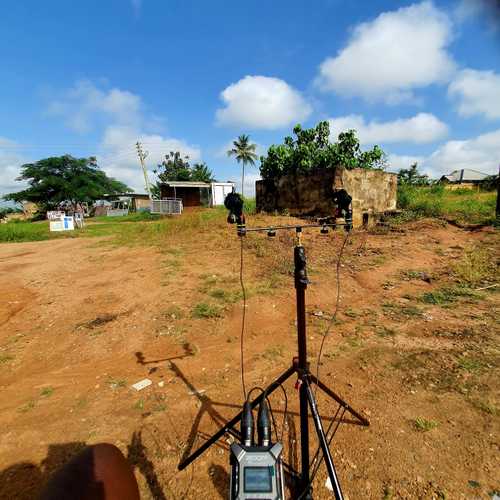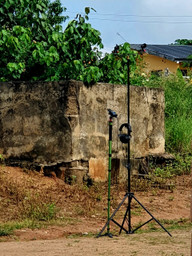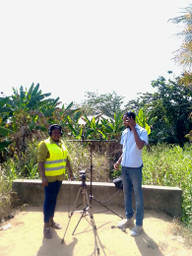
Introduction to The Centre for Soundscape Ecology & Multimedia training program in Ghana
My earliest inspiration in ecology and sound came from Bernie Krause’s The Great Animal Orchestra. This piece was played over a loudspeaker-orchestra system when I was a student in the Studio for Electroacoustic Music (SeaM) at Bauhaus-Universität Weimar, Germany. The collective richness of the species’ sounds I was hearing—and their relationship to music composition—captivated me and made me think that there was a correlation between notated/acousmatic music and the voices of the animal world. As a result, I decided to specialise in soundscape ecology, to help raise awareness about species and the ecosystems which make them thrive.
As part of my master’s degree studies at Bauhaus-Universität Weimar, I developed a soundscape ecology curriculum with the help of my supervisor. Not long after this, I launched the non-profit Centre for Soundscape Ecology and Multimedia (CSEM), but needed support in acquiring a field-recording equipment set.
In 2023, I was happy to see a post on a field-recording group on Facebook which mentioned Earth.fm offering grants to locals for field recordings. I reached out to explore supplying pure nature field recordings and assistance for developing local talent. I was warmly welcomed by the site’s curator, Melissa Pons, who facilitated all deliberations and made it possible for me to receive two field-recording sets and accessories for Ghana.
Since then, the training project has been going on successfully; the mentees are busily working towards field recording in two pristine Ghanaian ecosystems for Earth.fm.
The Centre for Soundscape Ecology and Multimedia Ghana training program is designed to transfer knowledge and skills in soundscape ecology and multimedia to both young people and adults.
The program uses a structured curriculum developed under Professor Robin Minard during my Master Study program at Bauhaus-Universität Weimar. I discussed with him and my then lecturer Robert Rennig the idea of transferring Soundscape Ecology knowledge and skills to Africa, since this field is not widely studied in the region.
I was particularly interested in carrying out this project in the context of conservation; therefore, recording fragile ecosystems and using immersive sound installations to educate on this subject are CSEM’s ultimate goals.
The project is structured around three areas of competency: Ecology and Soundscape Studies, Acoustic Engineering, and Multimedia Design.
Subtopics are as follows:
- Ecosystems and How They Work;
- Habitats and How They Work;
- What Is Biodiversity?;
- Species of Ecosystems;
- Listening to Ecosystems;
- Analysing and Monitoring of Ecosystems through Sound;
- Man and Ecosystems: The Effects on the Soundscape;
- Case Study: Wetland Ecosystems in Suburban Ghana;
- Case Study: Ramsar Sites in Ghana;
- Object-Based Recording;
- Soundscape Recording;
- Binaural Sound;
- Ambisonics;
- “Atmostree” Technology;
- How to Build Binaural Microphones;
- How to Build Cardioid and Omnidirectional Microphones;
- Monitoring, Editing, and Sound Analysis with DAWs [digital audio workstations];
- Mastering of Field Recordings for Sound Installations: Macro Photography;
- Multimedia Terminal Design;
- Sound Installation Planning;
- Graphic Design;
- Visual Communication;
- Sound Art for Biodiversity Communication;
- Performance Art for Biodiversity Communication;
- Electroacoustic Music Composition and Biomusic;
- Soundmaps and Interactive Programming for Webspace.
This packed content is carried out in phases. The ultimate goal is to mentor young people to acquire knowledge and skills which will help them build their own conservation-themed projects in schools, public venues, libraries, and museums using sound, sound technologies, photography, and scientific data and references.

With my teaching, I start with the topics of listening to soundscapes with and without amplification. These topics describe how to listen to the soundscape with the ears alone and with microphones and field recorders.
This training opens a new world of sound to participants. Because habitats which are dense and thriving can be heard with our ears as well as with microphones and field recorders, listening is the first introduction to nature and sound in my practice and teaching. Trainees have been ‘wowed’ by what they have heard for the first time with these technologies. This experience draws them into the craft and keeps them exploring more and more. Their awareness of the environment is deepened and they develop sensitive and protective attitudes toward it.
Other aspects of the program include preparing young people with technical skills like making their own microphones, mastering their recordings, and designing physical sound-installation systems for public exhibition. With all these competencies, they can convincingly present information about the environment to the public.
Microphones on the market for specific types of recordings are quite expensive, so I try to be creative and innovative around the subject and help mentees to access these tools which are so critical to their work. I also focus on the teaching of binaural sound because of its immersive, aesthetic, realistic, sonically appealing, and accurately localised sound qualities. With binaural technology, we can recreate sonic environments, transporting sound-installation listeners into those habitats. Closed-back headphones are standard for listening to sound environments in installations because of their isolation qualities. A minimalist approach to installation design means that they can be realised without a heavy budget.

To gain more scientific and authoritative references related to specific habitats, mentees work with conservation scientists, bioacousticians, and ecologists with diverse specialisations to learn about species, habitats, and ecology, informing their work. In some projects, ecologists are an integral part of fieldwork from the beginning of the project to its final installation.
Fostering interdisciplinary synergies has the potential to influence policymaking around fragile ecosystems. I also integrate into my training programs data resources, publications, and reference materials about species, environmental degradation, and climate action. Keeping captivating photographic profiles of relevant species makes installations attractive, so I also involve experienced macro photographers in the training.
The program has been kicked off with Emmanuel Baffoe in Koforidua, Ghana – this first trainee is now training others to become multipliers in this field. The project received support for a complete set of field recording equipment from Earth.fm in 2023, which I flew to Ghana with between October and November 2024 to start working with the first batch of selected candidates.

Unfortunately, a day after my arrival, I fell ill and started immediate treatment. My original plan of putting together five selected trainees at the Graduate School Auditorium of All Nations University in Koforidua was no longer viable, because my voice was inaudible. I called Emmanuel, who used to visit me, and gave him field recording tips and conducted field recordings at home and in the evening.
We covered topics related to stereo field monitoring (the movement of objects in space), focused and peripheral listening, how omni-directional microphones work, balanced placement of microphones, handling field recorders and batteries, listening with amplification, and closed-back/open-back reference headphones and how they work.
Having demonstrated quick, independent learning since the mentorship continued remotely from November 2024, Emmanuel has started passing on his knowledge to a female leader who will be spearheading a new project called Women in Soundscape Ecology Africa (WISEA).
WISEA is a soundscape ecology education program targeted at young girls and women in schools and other professionals. Dynamic young girls and female leaders are selected and mentored to acquire knowledge in acoustic engineering, ecology, and multimedia presentation. These skills will help them build their own conservation-themed projects in schools, public venues, libraries, and museums.
This concept has been accepted enthusiastically by female leaders in ecology, field recording, advanced acoustic engineering, conservation leadership, and bioacoustics, and among PhD researchers across Europe, Africa, Asia, and North and South America. The enthusiasm shared during introductory meetings was captivating and I believe women can carry this initiative very far. Further updates will be shared.
Currently, Emmanuel is recording in degraded wetland sites in Koforidua, adding to CSEM’s existing binaural archives, which were gathered between 2001 and 2002. These will be used for an upcoming installation on wetlands and their effect on biodiversity and human life.
He has also recently embarked on a field recording project in pristine and critically endangered ecosystems for educational and outreach programs, and for publication on Earth.fm. The project has selected all six Ramsar sites [wetlands designated as being of international importance under the Ramsar Convention on Wetlands] in Ghana, and two forest reserves: the Atewa Range Forest Reserve and the Bobiri Butterfly Sanctuary. All of these ecosystems are home to rich biodiversity, and are critical to the survival of the diverse and endangered species which occur there, but are at risk from mining, and human settlement and encroachment.
Sadly, Emmanuel is facing issues regarding transportation and accommodation costs, so I would respectfully like to request any support – be it financial or in kind – which could help this noble and critical endeavour. Thank you very much in advance for responding to this call.
Featured photo: Field practice, anthrophonies and biophony in suburban Ghana
All photos courtesy of Samuel Kudjodzi
Earth.fm is a completely free streaming service of 1000+ nature sounds from around the world, offering natural soundscapes and guided meditations for people who wish to listen to nature, relax, and become more connected. Launched in 2022, Earth.fm is a non-profit and a 1% for the Planet Environmental Partner.
Check out our recordings of nature ambience from sound recordists and artists spanning the globe, our thematic playlists of immersive soundscapes and our Wind Is the Original Radio podcast.
You can join the Earth.fm family by signing up for our newsletter of weekly inspiration for your precious ears, or become a member to enjoy the extra Earth.fm features and goodies and support us on our mission.
Subscription fees contribute to growing our library of authentic nature sounds, research into topics like noise pollution and the connection between nature and mental wellbeing, as well as funding grants that support emerging nature sound recordists from underprivileged communities.

